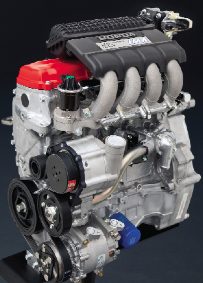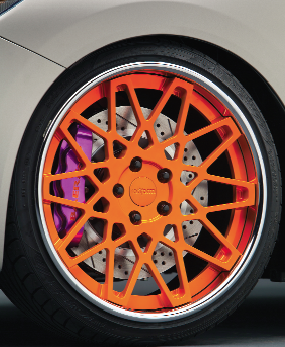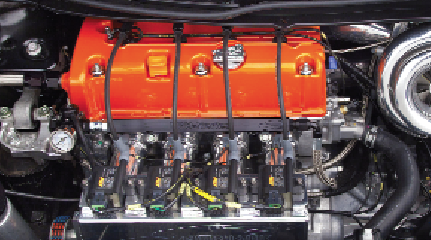To even the casual observer, it’s obvious that the “fast and furious” nature of the import performance market has cooled down. While not as common as it once was, there is still some excitement in the market and you shouldn’t be surprised to find a customer at your front counter who’s looking for a shop that is willing and able to do this kind of work.
 You also shouldn’t be surprised if the customer is driving a Honda — a long-time favorite with the performance-oriented customer. In this article, we’ll talk about how the performance market has changed over the years and what kind of opportunities you could expect, many for which your customers will procure their own parts (you’ll need to take some caution here).
You also shouldn’t be surprised if the customer is driving a Honda — a long-time favorite with the performance-oriented customer. In this article, we’ll talk about how the performance market has changed over the years and what kind of opportunities you could expect, many for which your customers will procure their own parts (you’ll need to take some caution here).
The first question you have to answer is whether you’re interested in this type of work. You have to have a technician who possesses the skills and mindset to handle performance-related upgrades, since this type of work can present some challenges that may require some common-sense engineering along the way to ensure a good outcome.
But, keep in mind that the customer who cares enough about his car to upgrade it appreciates and expects quality work, so price it accordingly and give it to the tech who will do the best job with it.
SUSPENSION MODIFICATIONS
When it comes to performance work, you’ll find that some of the most common upgrades are suspension related. The most prevalent are short, stiff springs that lower the car and its center of gravity, improve handling and provide that certain “look” your customer desires. In the old days, it wasn’t uncommon to simply cut a coil off the old springs to accomplish this task. But, thankfully, things have changed and there are now plenty of choices out there for the Honda driver when it comes to suspension upgrades. Hopefully your customer was a smart shopper and has purchased parts that will deliver what he expects. I won’t install something that I’m not comfortable with and I always ask my customer about his/her expectations.
Most of these customers are informed buyers, but you may have someone who needs to be educated in how the suspension components work together and how important it is to look at it as a system rather than individual parts. If you’re going to run the stiffer springs, the customer should consider a shock (or damper) upgrade at the same time. Or, maybe stiffer sway bars and a shock (or damper) upgrade will be a better choice rather than the lower springs.
While the attraction to the shorter springs is that lowered “mean” look that is so desirable, along with it comes less ground clearance, less suspension travel and the possibility of suspension geometry issues. The ground clearance issue is known when the springs are purchased, and hopefully the customer considered the conditions of the roads in the area and how he plans to use the car when choosing parts.
Of course, it only makes sense to consider the shock upgrade as the springs are being installed. We all know the job of the shock is to control the actions of the spring. What is not so obvious, however, is the role the shocks play in vehicle control.
Many of the performance shocks available will be adjustable, with most offering a single adjustment on the rebound stroke. This only makes sense as you think about the system. If you replace a 350-lb. spring with one rated at 500 lbs., it wouldn’t be surprising to find the standard shock isn’t up to controlling the return rate of the new spring. With the adjustable shock, you can compensate for different spring rates and the driver can tune the rebound rate to his liking. While the rebound rate is important for spring control, it also plays a significant role in vehicle dynamics as they control how the weight is transferred through the chassis in a turn.
As the car enters a turn, the weight transfers to the loaded wheels, compressing the springs, and while the unloaded side is extending, it’s the shock rebound rate that controls how quickly that weight will move. As you move up the list of what’s available for shocks, both the features and price will increase, with the high-end shocks used by race teams running into the thousands of dollars. If you’re not doing track day or race preparation, I’ll doubt you’ll be seeing many of those.
An option that addresses many of the problems associated with a spring change is a coil-over kit. This kit includes a strut assembly with an adjustable lower spring seat and, in some cases, a top strut mount, or adjustable caster camber plate. The advantages of this system include a strut that is valved for the included spring. And, the shock body is usually shortened to maximize suspension travel by increasing the space from the top strut mount to the shock.
But the biggest advantage is that the ride height can be adjusted by moving the lower spring seat. This adjustability gives the owner the choice to run the car lower for shows or track days and restore it back to a more suitable height for daily driving. However, changing ride height requires that the wheel alignment is readjusted.
The part of the system we haven’t talked about are sway bars, but they should be better named anti-sway bars. They are ideal for the customer who is interested in improving the car’s handling, but isn’t necessarily interested in lowering the car. They should consider an upgrade of the sway bars; this will increase the effective spring rate without the negative side effects associated with stiff springs. An upgrade to performance shocks and stiffer sway bars will pay dividends in performance with little compromise to ride quality and no change to the ride height.
BRAKE, TIRE & WHEEL UPGRADES
 Another popular upgrade area is the brakes and, just like with suspension components, there are many options available. The most common upgrades involve pad, rotor and brake hose upgrades, but they can go as far as aftermarket calipers and oversized rotors. Some kits include big rotors and use calipers from another model to complete the kit.
Another popular upgrade area is the brakes and, just like with suspension components, there are many options available. The most common upgrades involve pad, rotor and brake hose upgrades, but they can go as far as aftermarket calipers and oversized rotors. Some kits include big rotors and use calipers from another model to complete the kit.
Most of these kits are designed to function with the stock master cylinder and ABS systems, but like the suspension parts, I always want to know the manufacturer of the parts I’m installing and insist on contact information and seeing the paperwork involved. Installing the upgraded brake parts won’t present any challenges for the experienced tech.
If the rotors or calipers have been upgraded, care must be taken to be sure that there is sufficient clearance between the calipers, the brake hoses and the wheel. Of course, the brake fluid should be flushed with a high-quality fluid that will stand up to the hard brake usage that would be expected.
Wheel and tire upgrades are probably the first changes made as the driver looks to personalize his car. Some of the brake upgrades we just discussed are motivated by the desire to better fill in the area behind the wheel. Many of the wheel designs are more open in the center, making the appearance of the brakes more important. I think it’s safe to say that most enthusiast consumers today look to the Internet for their performance parts and that certainly includes wheel and tire purchases.
The Internet suppliers have done a good job with their websites, and if you’re looking for a wheel and tire package for your Honda you can go online and actually see how the package will look on the car. As shop owners, we hate to see a parts sale go elsewhere, but I believe it’s a sign of the times. One way to keep your name out there with the on-line tire distributers is to list your shop as a recommended installer for the products they sell and to participate in any wholesale program that’s available.
Back under the vehicle, we’re now looking at the exhaust system as the next system to get the upgrade treatment. Again, there are options and many customers will opt for a cat-back system or rear exhaust section, depending on their budget and expectations. One thing no one expects is a final product that is rubbing against the body or rattles with every bump in the road. Installing these systems is the same as replacing stock parts, except that they are usually larger in diameter and the tailpipe may be a different configuration.
Be sure that the system is actually hanging on good hangers and there is sufficient clearance around the pipes. It may be necessary to do some trimming around the tailpipe to gain some clearance, but that shouldn’t create much of a challenge. The cat-back system will provide the look and sound that the customer desires, but the more serious enthusiast may opt for the extra power and torque that a set of headers will deliver.
Tuned tubular headers replace the stock exhaust manifold and downpipe with four equal length tubes that terminate in a single-pipe collector. While the tubes do a good job of getting the exhaust from the engine to the catalytic converter, most of the performance gain is the result of better cylinder filling as the negative pressure (vacuum) in the exhaust tube draws intake air in while both valves are open during overlap.
As you can imagine, a good deal of time and effort goes into the design and testing of an effective set of headers and it takes good-quality control to deliver a product that will seal well and be suitable for daily street use. For all these reasons, you get what you pay for. If you have a client who insists on installing one of the bargain brands, be sure he understands that while you will guarantee the parts will be installed properly, you can’t and won’t stand behind any manufacturer problems.
UNDERHOOD UPGRADES
 Now that we’re done under that car, we’ll spend a couple of minutes talking about underhood modifications. The most common modification you’ll see here involves the air intake, and the customer will handle most of those changes. It might be as simple as a high-flow filter element, or a complete cold air intake system that relocates the air intake to a more advantageous place for drawing cooler, denser air into the engine.
Now that we’re done under that car, we’ll spend a couple of minutes talking about underhood modifications. The most common modification you’ll see here involves the air intake, and the customer will handle most of those changes. It might be as simple as a high-flow filter element, or a complete cold air intake system that relocates the air intake to a more advantageous place for drawing cooler, denser air into the engine.
The installation of these systems is straightforward but, like the exhaust system, be sure it’s routed and secured properly to prevent contact and the resulting rattles that it will bring. Another downside to the cold air system is that often the area chosen to draw the air is lower in the body, making it more likely to pull in water. Like the headers, it pays to invest a few extra dollars and get a system that was designed for the job and the car. A quality manufacturer will take the wet-weather situation into consideration, as well as providing relocating battery brackets, if needed.
I don’t have the space to get into the more extensive engine modifications, cam changes, engine swaps, turbos and supercharging, and ECU tuning other than to say all these options are available for every car in Honda’s lineup. These are big jobs that can be profitable if you have right tech, and if these are the types of jobs your shop can handle.
Now that we looked at the various performance upgrades and see that this work is very similar to the everyday jobs we’re currently handling on Hondas, is there any reason not to welcome this kind of work into your bays? I don’t see a downside. The customers you attract with this kind of work are often identified as the “car guy” within his family, workplace and social circles, who will surely spread the word about your quality work, and that is never a bad thing for your shop’s reputation. And, who knows, you might even enjoy this kind of work.


